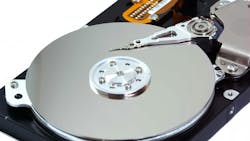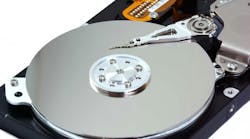Shingled Magnetic Recording: What Is It and How Does It Work?
What you’ll learn:
- What is SMR and what it can enable?
- What applications are ideal for SMR pairing?
- How to tell if SMR storage solutions are right for your data center.
Driven by an explosion of data creation and retention needs, hard-disk-drive (HDD) storage capacities and data-center densities are rapidly expanding thanks to a technology called shingled magnetic recording (SMR) (see figure). Using a recording technology that overlaps data tracks like shingles on a roof, SMR HDDs will increase areal density and corresponding disk capacity beyond the 26-TB barrier within the same 3.5-in. HDD footprint.
Enterprises that adopt SMR technology and zoned storage can leverage higher-density storage systems and architectures compared to those using today’s conventional-magnetic-recording (CMR) HDDs. SMR drives deliver significant total cost of ownership (TCO) advantages relative to CMR for data centers and hyperscale cloud operators who want the highest-capacity drives while working within the existing form factor, performance, and power envelope of today’s CMR HDDs. SMR and CMR HDDs are available with SATA and SAS interfaces.
So, what exactly is SMR? Should you deploy it unilaterally across your data center? What are the ideal applications to pair SMR with? What do you need to know to roll out SMR in your data center today? Let’s dive in.
Why Do We Need Shingled Magnetic Recording?
Innovative cloud architectures and solutions, artificial intelligence (AI), the Internet of Things (IoT) and other big-data initiatives are creating new, data-driven requirements that change how enterprises think about data storage. Massive amounts of data are being generated that must be stored, analyzed, maintained, and archived efficiently. This is based on various and dynamic data-storage needs, data sovereignty and retention policies, and “zero trust” authentication, while maintaining reasonable levels of data accessibility.
Even though the storage industry continues to increase the bit density of both HDDs and solid-state drives (SSDs) to keep up with data growth, dramatic innovation is still needed to drive greater storage efficiency at scale. Enter SMR.
Storage is fundamental to creating value from data. HDD-stored data is increasingly important when it comes to creating enormous training datasets to enable AI and machine-learning (ML) capabilities. The challenge is how to efficiently and cost-effectively build data-storage infrastructure that will keep pace with data demands while lowering the TCO.
SMR drives enable enterprises to cost-effectively increase data-storage density within the same data-center footprint. Thus, savings on real estate, power, cooling, server racks, and the associated cabling and networking equipment, as well as labor and maintenance costs, can be realized.
SMR in the Data Center: Who and How
It’s important to talk about what SMR drives are not. SMR drives aren’t for everyone as they’re not direct drop-in replacements for today’s traditional CMR HDDs in all applications. For hyperscale and enterprise data-center customers, it’s a complementary technology that requires an upfront investment and commitment in modifying the host or software stack to take advantage of the sequential nature of how the HDDs write, store, and manage data on the drive.
As mentioned, SMR achieves higher areal density by overlapping tracks on top of each other. This allows HDD engineers to squeeze more tracks per inch into the same space as traditional CMR devices. However, this unique architecture requires data to be stored sequentially because the data can’t be overwritten in place, as in a CMR drive.
Using the shingled roof analogy to think of this another way, data written onto one row of shingles must be written in a continuous row or band before another overlaps it. Such an approach maximizes areal density at the cost of being able to overwrite individual tracks. The tracks are grouped into “zones,” and a zone can only be written from its start sequentially to its end. This requires active management from the host software stack to follow the rules of zone-based writing.
What are the Ideal Applications for SMR?
SMR HDDs are designed for sequential write workloads such as bulk storage and online backup and archive, where storage density, watt/TB, and cost/TB are critical parameters. They target environments where the data is sequentially written and rarely require update-in-place. Such target areas include video surveillance, online archives, cloud storage, storage for regulatory compliance, big-data storage, and other applications where the data is write-once read-many (WORM), including large model sets used as training data for AI/ML. These examples are usually designed around data being written in sequential order; SMR provides an opportunity for intelligent data handling for those specific applications.
Is Shingled Magnetic Recording Right for My Data Center?
What follows are six drive characteristics and benefits to consider when evaluating whether SMR storage solutions are right for your data-center applications:
- Highest storage capacity: Compared to CMR drives, SMR HDDs generally offer a 10% or larger storage density advantage. Modifying the software stack is a one-time change that allows for a forward migration path to future high-capacity SMR products. Investment today gives data-center customers a time-to-market advantage in designing the highest-density HDD-based solutions.
- Improve time to access: Enterprise SMR drives are host-managed, meaning that an intelligent host software stack handles data placement. This can vastly improve time to access compared to older drive-managed SMR technologies, while maintaining higher storage densities than CMR drives. Thus, organizations can take advantage of host-managed SMR drives for applications such as archival and object storage with lower TCO solutions and still maintain a fast time to access archived data.
- Increased capacity per HDD: Gaps between recording tracks impact areal density in CMR drives since parts of the platter can’t be utilized. Because SMR drives write data sequentially and then overlap tracks of data, this eliminates the need for gaps between recording tracks, vastly improving areal density and, thus, available user capacity.
- No limitations in read commands: SMR is able to achieve these improvements in capacity without impacting the performance of read commands. Like other HDDs, a narrower read head can “read between the lines” and isolate each single track. Moreover, even though random writes aren’t supported, random reads are allowed.
- Don’t sacrifice performance for capacity: The most technologically advanced SMR drives have embedded flash storage on the drive itself that stores critical metadata in non-volatile media instead of on rotating media. This makes it possible to narrow the write tracks while using memory with a bigger cache, ultimately improving capacity without impacting performance.
- Ecosystem support is rapidly maturing: Early adopters of host-managed SMR were forced into a “do-it-yourself” model, meaning they had to manually change their software at all levels to support SMR. Today, improvements in the Linux kernel and enterprise file systems like btrfs are making adoption much more possible for a wider range of potential users by offering “drop-in” support for some SMR-friendly applications.
The recent data explosion is forcing organizations to rethink how they store and archive their most important assets and critical data in the data center. SMR drives will become more pervasive and ubiquitous in the future. This proven technology is pushing the boundaries of high capacity in HDDs while offering increased density and improved TCO. Customers who invest in SMR can ensure that their investment is fully leveraged for subsequent generations of SMR products and achieve a time-to-market advantage.
About the Author
Brad Warbiany
Director of HDD Technical Marketing, Western Digital
Brad Warbiany is the Director of HDD Technical Marketing at Western Digital. Brad has been with Western Digital for over 16 years, having held previous positions at SiliconSystems, Advantech, and Altera. He holds a Certificate in Management for Technical Professionals from the Paul Merage School of Business at the University of California, Irvine and a bachelor’s degree in electrical engineering from Purdue University.


